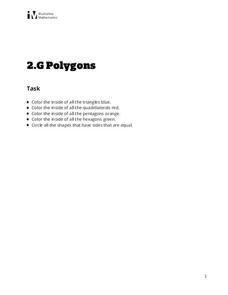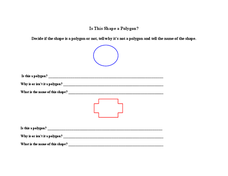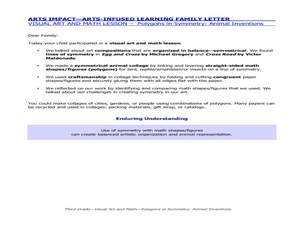Curated OER
Naming Polygons
What polygon is this? Young geometers categorize shapes by circling all the quadrilaterals in a set of figures. Next, they write the names of 10 polygons using a visual guide as reference. Review the guide together before they start if...
Illustrative Mathematics
Polygons
Identify shapes based on their attributes. Second graders are tasked to color triangles, quadrilaterals, pentagons, and hexagons specific colors. The one thing these shapes have in common? They are all polygons.
Curated OER
Is This Shape a Polygon?
In this identifying polygon shapes worksheet, students observe different shapes, determine if they are polygons are not, explain why they are or are not polygons, and name the shapes. Students write 12 answers.
Curated OER
Classifying Polygons
A straight edge, a right angle, a number of vertices; sounds like it's time to classify polygons. That's right you and your class will learn all about the properties of polygons and how to classify them with this easy to follow...
Curated OER
Congruent Polygons: Copying Stretchy Shapes
Third graders investigate congruent polygons through dance. In this congruency instructional activity, 3rd graders do the "brain dance" as a warm up. They review polygon names by singing "The Polygon Chant," before mirroring congruent...
Curated OER
Spotting Polygons
See all sides of the story with a worksheet on geometric shapes! After studying the example at the top, which matches polygons with solid figures, second graders circle shapes that are named in the directions. Next, they match polygons...
Alabama Learning Exchange
Polygons-Changing Area Versus Changing Perimeter
Investigate the area and perimeter of polygons in this geometry lesson. Young geometers use grid paper to draw a quadrilateral and calculate its area and perimeter. They also read The Greedy Triangle to identify the changing shape of...
Curated OER
Polygon People
Students identify polygons. In this polygon people instructional activity, students draw required shapes and construct a polygon person. They identify each shape and its characteristics. The instructional activity may be extended by...
Curated OER
Identify Polygons: Algebra/Geometry Institute
Eighth graders classify geometric figures. In this polygon lesson, 8th graders identify given geometric figures. They compare and contrast different polygons. Students name line segments, identify parallel lines, and interesections. ...
K-5 Math Teaching Resources
Polygon Sort Sheet
What makes a polygon a polygon and how many different types are there? Invite your scholars to learn and discuss that question with this polygon sort sheet. Learners cut out each polygon and sort them by their different attributes.
Curated OER
Know Your Polygons!
Students identify and categorize different polygons. In this polygons lesson plan, students research and identify properties of polygons, identify different polygon shapes, and categorize different triangles and quadrilaterals.
Curated OER
Area of Polygons
Students engage in a lesson that is about the concept of polygons and focuses upon finding the area. They use formulas provided in the lesson in order to solve problems given by the teacher for independent practice. Geometric figures are...
Curated OER
Polygons Homework
In this polygons worksheet, students identify polygons that contain given parameters. They write definitions of polygons. Students find the measurement of exterior and interior angles of regular polygons. This two-page worksheet...
Curated OER
Attributes of Polygons: Stretchy Shapes
Fourth graders use dancing methodology in a polygon and shape activity. In this shape and dance instructional activity, 4th graders discuss shapes in dance, math, and everyday life. Students use dancing activities to recognize and...
Curated OER
Polygons in Symmetry: Animal Inventions
Fourth graders use polygons to create animal figures with symmetry. In this polygons and symmetry lesson, 4th graders create a symmetrical animal collage by cutting and gluing geometric shapes and figures from math activities.
Curated OER
Countdown Challenge: Live Symmetry in Regular & Irregular Polygons
In this symmetry activity, learners identify lines of symmetry in given polygons. They discover the correlation between the number of sides and the number of lines of symmetry. Students determine the lines of symmetry in irregular...
Alabama Learning Exchange
Polygon Perimeters
What are polygons? Learners find the perimeter of various geometric figures that the teacher has drawn in chalk on the sidewalk. A worksheet to record their measurements is provided. Get your third graders outside and exploring the world...
Arizona Department of Education
Area and Perimeter of Regular and Irregular Polygons
Extend young mathematicians' understanding of area with a geometry lesson on trapezoids. Building on their prior knowledge of rectangles and triangles, students learn how to calculate the area of trapezoids and other irregular...
Curated OER
Regular & Irregular Polygons
In this polygons instructional activity, 7th graders identify and complete 8 different problems that include determining the types of various polygons. First, they use the table to the left to color each of the polygons illustrated....
Curated OER
Pop-it...Stop-it
Students observe how certain geometric shapes can be used to make some structures rigid and others flexible. The activity involves construction of a 30-60 right triangle, folding while following directions, and identifying polygons.
Curated OER
Is it a Polygon?
Second graders investigate polygons. In this geometry lesson, 2nd graders practice identifying characteristics of polygons on the overhead using a T-45 calculator display. Students play the game "Guess My Rule" to identify what polygons...
Curated OER
Classify and Identify Polygons
In this polygon worksheet, students observe pictures of polygons and identify their proper name. They read descriptions of polygons and determine the polygon described. This one-page worksheet contains ten problems.
Curated OER
Finding Polygons in Cubist Art
Fourth graders explore geometric properties and relationships in a two-dimensional work of art. They first search for and identify polygons in a Cubist painting and then use polygons to create their own Cubist portrait of a classmate.
Think Map
Know Your Polygons!
Shape shifters recognize characteristics of polygons. Embracing language arts skills in addition to math, they use a thesaurus to pinpoint specific attributes of a set of polygons. They also participate in a 21-question guessing game...

























